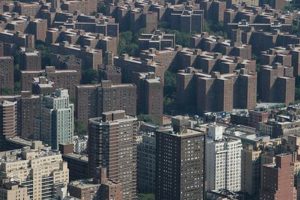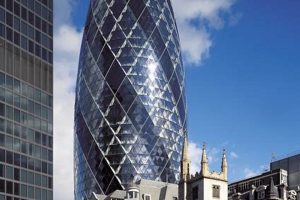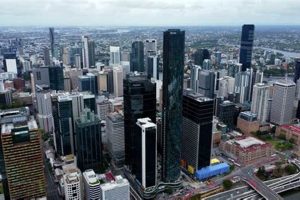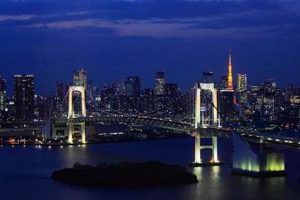Austin, the capital of Texas, is known for its rapidly growing skyline. In recent years, several skyscrapers have been constructed in the city, making it one of the most dynamic and architecturally diverse cities in the United States. The tallest building in Austin is the Independent, which stands at 685 feet tall. Other notable skyscrapers in the city include the Austonian, the 360 Condominiums, and the Frost Tower.
The construction of skyscrapers in Austin has been driven by the city’s strong economy and population growth. Austin is home to a number of Fortune 500 companies, including Dell, Apple, and Google. The city’s population has also grown rapidly in recent years, making it one of the fastest-growing cities in the United States. The construction of skyscrapers has helped to meet the demand for housing and office space in the city.
The skyscrapers in Austin have had a significant impact on the city’s skyline and economy. They have helped to create a more vibrant and cosmopolitan city, and they have attracted new businesses and residents to the city. The skyscrapers in Austin are also a testament to the city’s growing prominence as a major economic and cultural center in the United States.
1. Height
Height is one of the most important factors that define a skyscraper. The height of a skyscraper is determined by a number of factors, including the building’s intended use, the local zoning laws, and the available construction technology. In general, taller skyscrapers are more expensive to build and maintain than shorter skyscrapers. However, they can also be more prestigious and offer more stunning views. The biggest skyscrapers in Austin are all over 500 feet tall, with the tallest being the Independent, which stands at 685 feet tall.
The height of a skyscraper can have a significant impact on its design and construction. For example, taller skyscrapers require more robust structural systems to withstand wind and seismic forces. They also require more complex mechanical systems to pump water and air to the upper floors. As a result, taller skyscrapers are often more expensive to build than shorter skyscrapers.
Despite the challenges, there are a number of reasons why developers build tall skyscrapers. One reason is that taller skyscrapers can offer more rentable space than shorter skyscrapers. This is because taller skyscrapers can have more floors, and each floor can be larger than the floors in a shorter skyscraper. Another reason to build tall skyscrapers is that they can be more prestigious than shorter skyscrapers. A tall skyscraper can be a symbol of a city’s wealth and power, and it can attract tenants who want to be associated with that image. Finally, tall skyscrapers can offer stunning views of the surrounding area. This can be a major selling point for tenants, especially for those who work in the building’s upper floors.
2. Architecture
Architecture plays a vital role in shaping the biggest skyscrapers in Austin. The design of these skyscrapers is influenced by a variety of factors, including the building’s intended use, the local climate, and the available construction technology. The biggest skyscrapers in Austin are all unique, but they share some common architectural features.
- Structural systems: The biggest skyscrapers in Austin are all supported by robust structural systems that can withstand wind and seismic forces. These systems typically consist of a combination of steel and concrete.
- Mechanical systems: The biggest skyscrapers in Austin require complex mechanical systems to pump water and air to the upper floors. These systems are typically designed to be energy-efficient and sustainable.
- Facade design: The facade of a skyscraper is its exterior surface. The facade design of the biggest skyscrapers in Austin is often used to create a distinctive look for the building. These facades can be made from a variety of materials, including glass, metal, and stone.
- Sustainability: The biggest skyscrapers in Austin are increasingly being designed with sustainability in mind. These skyscrapers often feature energy-efficient systems, green roofs, and other sustainable features.
The architecture of the biggest skyscrapers in Austin is a reflection of the city’s growing prominence as a major economic and cultural center in the United States. These skyscrapers are not only landmarks, but they are also symbols of the city’s ambition and prosperity.
3. Location
The location of a skyscraper is one of the most important factors that determines its success. The biggest skyscrapers in Austin are all located in prime locations, close to major transportation hubs and amenities. This makes them attractive to tenants who want to be in the heart of the city.
One of the most important factors to consider when choosing a location for a skyscraper is the availability of transportation. The biggest skyscrapers in Austin are all located near major highways and public transportation lines. This makes it easy for tenants to get to and from work. It also makes it easy for visitors to come to the city and visit the skyscrapers.
Another important factor to consider when choosing a location for a skyscraper is the availability of amenities. The biggest skyscrapers in Austin are all located near a variety of amenities, including restaurants, shops, and entertainment venues. This makes it easy for tenants to find everything they need within walking distance of their office or apartment.The location of a skyscraper can also have a significant impact on its views. The biggest skyscrapers in Austin all offer stunning views of the city and the surrounding area. This is a major selling point for tenants, especially for those who work in the building’s upper floors.Overall, the location of a skyscraper is a critical factor that determines its success. The biggest skyscrapers in Austin are all located in prime locations, close to major transportation hubs and amenities. This makes them attractive to tenants and visitors alike.
4. Use
The biggest skyscrapers in Austin are used for a variety of purposes, including office space, residential units, and retail space. Office space is the most common use for the biggest skyscrapers in Austin. Many of the city’s largest companies have their headquarters in the biggest skyscrapers. Residential units are also a common use for the biggest skyscrapers in Austin. These units offer stunning views
of the city and the surrounding area. Retail space is also found in the biggest skyscrapers in Austin. This space is often used for high-end shops and restaurants.
The use of the biggest skyscrapers in Austin has a significant impact on the city’s economy. The office space in these skyscrapers provides jobs for thousands of people. The residential units in these skyscrapers help to attract new residents to the city. The retail space in these skyscrapers generates tax revenue for the city. Overall, the biggest skyscrapers in Austin are a major economic driver for the city.
The use of the biggest skyscrapers in Austin is also changing. In recent years, there has been a trend towards mixed-use developments. These developments include a mix of office space, residential units, and retail space. This trend is expected to continue in the future, as developers seek to create more vibrant and sustainable communities.
5. Tenants
Tenants play a critical role in the success of the biggest skyscrapers in Austin. These skyscrapers are home to a diverse range of tenants, including Fortune 500 companies, government agencies, and non-profit organizations. The presence of these tenants helps to create a vibrant and dynamic urban environment.
- Office Tenants
Office tenants are the most common type of tenant in the biggest skyscrapers in Austin. These tenants include a wide range of companies, from small startups to large corporations. The presence of these tenants helps to create a strong and diverse economy in the city.
- Residential Tenants
Residential tenants are also a common type of tenant in the biggest skyscrapers in Austin. These tenants include a mix of individuals and families. The presence of these tenants helps to create a more vibrant and livable city.
- Retail Tenants
Retail tenants are also found in the biggest skyscrapers in Austin. These tenants include a mix of high-end shops and restaurants. The presence of these tenants helps to create a more vibrant and exciting urban environment.
- Government Tenants
Government tenants are also found in the biggest skyscrapers in Austin. These tenants include a mix of local, state, and federal agencies. The presence of these tenants helps to create a more efficient and effective government.
The tenants in the biggest skyscrapers in Austin play a vital role in the city’s economy and culture. These tenants help to create a vibrant and dynamic urban environment that is attractive to businesses and residents alike.
6. Views
The views from the biggest skyscrapers in Austin are simply breathtaking. On a clear day, one can see for miles in every direction. This is one of the main reasons why people choose to live and work in these buildings.
The views from the biggest skyscrapers in Austin can have a significant impact on the quality of life for the people who live and work in them. Studies have shown that people who have access to natural light and views of the outdoors are happier and healthier. They also tend to be more productive and creative.
The views from the biggest skyscrapers in Austin can also be a major selling point for businesses. Companies that are located in these buildings can attract and retain top talent by offering them access to stunning views of the city. The views can also help to create a more positive and productive work environment.
Overall, the views from the biggest skyscrapers in Austin are a major asset to the city. They make the city a more attractive place to live, work, and visit.
7. Sustainability
Sustainability is a major concern for the biggest skyscrapers in Austin. These buildings consume a lot of energy and resources, and they can have a significant impact on the environment. As a result, many of the biggest skyscrapers in Austin are being designed and constructed with sustainability in mind.
- Energy efficiency
One of the most important aspects of sustainability is energy efficiency. The biggest skyscrapers in Austin are using a variety of strategies to reduce their energy consumption, including:
- Using energy-efficient lighting systems
- Installing solar panels
- Using green roofs
- Improving insulation
- Water conservation
Water conservation is another important aspect of sustainability. The biggest skyscrapers in Austin are using a variety of strategies to reduce their water consumption, including:
- Using low-flow plumbing fixtures
- Installing rainwater harvesting systems
- Using drought-tolerant landscaping
- Waste reduction
Waste reduction is another important aspect of sustainability. The biggest skyscrapers in Austin are using a variety of strategies to reduce their waste production, including:
- Recycling
- Composting
- Using sustainable materials
- Indoor environmental quality
Indoor environmental quality is also an important aspect of sustainability. The biggest skyscrapers in Austin are using a variety of strategies to improve the indoor environmental quality of their buildings, including:
- Using natural ventilation
- Using low-VOC materials
- Providing access to natural light
The biggest skyscrapers in Austin are leading the way in sustainability. These buildings are using a variety of innovative strategies to reduce their environmental impact. As a result, these buildings are helping to make Austin a more sustainable city.
8. Economic impact
The biggest skyscrapers in Austin have a significant economic impact on the city. These buildings generate tax revenue, create jobs, and attract new businesses to the city.
- Tax revenue
The biggest skyscrapers in Austin generate a significant amount of tax revenue for the city. This revenue can be used to fund a variety of public services, such as schools, parks, and libraries.
- Job creation
The biggest skyscrapers in Austin create jobs for thousands of people. These jobs include construction workers, engineers, architects, and property managers.
- Attracting new businesses
The biggest skyscrapers in Austin attract new businesses to the city. These businesses are drawn to the city by the presence of a skilled workforce, a strong economy, and a vibrant urban environment.
- Increased property values
The biggest skyscrapers in Austin have a positive impact on property values in the surrounding area. This is because these buildings make the area more desirable to live and work in.
Overall, the biggest skyscrapers in Austin have a significant economic impact on the city. These buildings generate tax revenu
e, create jobs, attract new businesses, and increase property values.
9. Cultural significance
The biggest skyscrapers in Austin are not just symbols of the city’s economic power; they are also significant cultural landmarks that reflect the city’s history, values, and aspirations. These buildings have played a major role in shaping the city’s identity and have become iconic symbols of Austin’s unique character.
- Architectural landmarks
The biggest skyscrapers in Austin are architectural marvels that have reshaped the city’s skyline. These buildings are designed by world-renowned architects and feature innovative and sustainable design elements. They have become iconic landmarks that are recognized around the world.
- Symbols of economic prosperity
The biggest skyscrapers in Austin are symbols of the city’s economic prosperity. These buildings are home to major corporations and financial institutions, and they have played a major role in attracting new businesses to the city. The presence of these skyscrapers has helped to make Austin one of the fastest-growing cities in the United States.
- Centers of community and culture
The biggest skyscrapers in Austin are more than just office buildings; they are also centers of community and culture. These buildings often feature public spaces, art installations, and other amenities that are open to the public. They have become popular gathering places for residents and visitors alike.
- Reflections of the city’s values
The biggest skyscrapers in Austin reflect the city’s values of innovation, sustainability, and community. These buildings are designed to be environmentally friendly and to minimize their impact on the environment. They are also designed to be accessible to all people, regardless of their ability or background.
The biggest skyscrapers in Austin are more than just buildings; they are symbols of the city’s history, values, and aspirations. These buildings have played a major role in shaping the city’s identity and have become iconic symbols of Austin’s unique character.
FAQs on Biggest Skyscrapers Austin
This section addresses frequently asked questions about the biggest skyscrapers in Austin, providing concise and informative answers to common inquiries.
Question 1: What is the tallest skyscraper in Austin?
The tallest skyscraper in Austin is The Independent, standing at an impressive height of 685 feet.
Question 2: How many skyscrapers are there in Austin?
As of 2023, there are 40 completed skyscrapers in Austin, with several more under construction.
Question 3: What is the most iconic skyscraper in Austin?
The Frost Tower is widely regarded as the most iconic skyscraper in Austin due to its unique shape and striking blue glass facade.
Question 4: What are the biggest skyscrapers in Austin used for?
The biggest skyscrapers in Austin are primarily used for office space, offering premium business addresses and stunning views for corporate tenants.
Question 5: Are there any residential skyscrapers in Austin?
Yes, there are several residential skyscrapers in Austin, such as The Austonian and 360 Condominiums, which offer luxurious living spaces with panoramic city views.
Question 6: What is the future of skyscrapers in Austin?
Austin’s skyline continues to evolve, with several new skyscraper projects in the pipeline. These developments are expected to further enhance the city’s architectural landscape and contribute to its economic growth.
In summary, the biggest skyscrapers in Austin are iconic landmarks that symbolize the city’s rapid growth and economic vitality. They offer stunning views, premium office spaces, and luxurious residential units, contributing significantly to Austin’s urban fabric and skyline.
Transition to the next article section: Austin’s Architectural Legacy
Tips for Exploring Biggest Skyscrapers Austin
Discover the grandeur and architectural marvels of Austin’s biggest skyscrapers with these insightful tips:
Tip 1: Plan Your Visit
Research the skyscrapers you wish to visit, including their heights, unique features, and visiting hours. Consider scheduling guided tours to gain exclusive access and insights.
Tip 2: Capture Panoramic Views
Ascend to the observation decks or rooftop terraces of these skyscrapers to enjoy breathtaking panoramic views of the city and surrounding landscapes. Bring a camera to capture the stunning vistas.
Tip 3: Explore Public Spaces
Many skyscrapers in Austin feature public plazas, parks, and art installations at their base. Take advantage of these open spaces to relax, admire the architecture, and engage with the surrounding urban environment.
Tip 4: Visit During Special Events
Check local event calendars for special occasions, such as architectural exhibitions, light shows, or holiday celebrations, that take place at or near the skyscrapers. These events offer unique opportunities to experience these landmarks in a different light.
Tip 5: Consider Architectural Details
Appreciate the intricate designs, materials, and engineering feats of these skyscrapers. Pay attention to details such as facade patterns, window designs, and the interplay of light and shadow.
Tip 6: Learn About Sustainable Features
Inquire about the sustainable design elements incorporated into the skyscrapers, such as energy-efficient systems, rainwater harvesting, and green roofs. Understanding these features highlights the commitment to environmental responsibility.
Tip 7: Respect the Environment
When visiting the skyscrapers and surrounding areas, dispose of waste responsibly, conserve water, and minimize your environmental impact. Respect the beauty and grandeur of these landmarks for future generations to enjoy.
Tip 8: Embrace the Austin Skyline
Take time to admire the Austin skyline from various vantage points, including street level, nearby parks, or across the Colorado River. Capture the iconic cityscape and appreciate the architectural harmony and diversity that define Austin’s urban landscape.
Conclusion
The biggest skyscrapers in Austin stand as testaments to the city’s remarkable growth and economic vitality. These architectural marvels have reshaped the skyline, offering stunning views, premium office spaces, and luxurious residential units. Their designs showcase innovation, sustainability, and a commitment to enhancing the urban environment.
As Austin continues to grow and evolve, its skyscrapers will undoubtedly play a significant role in shaping the city’s future architectural landscape. They serve as reminders of the city’s ambition, resilience, and dedication to progress. By embracing these architectural marvels, we not only appreciate their aesthetic beauty but also contribute to the ongoing legacy of Austin as a dynamic and thriving metropolis.







